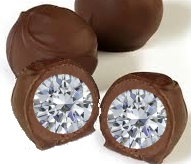
May Editorial
Chocolates and diamonds

May Editorial
Chocolates and diamonds
|
Everyone knows that a 'girl's best friends' are chocolates and diamonds, but do these two have anything else in common? They do indeed. What you first see (as with the girl herself) is only skin deep - and the surface may be deceiving.
|
According to Dr Thomas Gernon, Lecturer in Earth Science at the University of Southampton, candy and diamonds come pre-wrapped by a process which coats them with a smooth rounded layer of material. In this process, atomized droplets deposit a thin layer of liquid onto seed particles. The solvent for the droplets is then evaporated by something called ‘hot fluidizing’, leaving behind the dissolved material on the surface. The entire process, called ‘fluidised spray granulation’ occurs naturally during kimberlite eruptions. Here it produces well-rounded particles containing fragments from the Earth's mantle.The same process is frequently used by manufacturers to coat confectionery with a delicious layer of chocolate. |
|
|
In kimberlite pipes the geological structures, equivalent of the chocolate coated candy, are called 'pelletal lapilli '. Pelletal lapilli are discrete, smooth, spherical-elliptical lapilli of primarily igneous material, commonly with a single, megacrystic fragment or a lithic (small fragment of rock) at the centre. A characteristic feature of pelletal lapilli is a complex outer rim which is composed of several concentric lava layers. In kimberlite pipes the pelletal lapilli often contain diamonds, just as a truffle fudge can come with a hard outer shell of chocolate. Kimberlite volcanoes are the world’s primary source of diamonds. They are formed by gas-rich magmas which originate at mantle depths of over 150 km. Kimberlite volcanism involves high-intensity explosive eruptions, forming diverging pipes or 'diatremes', which can be several hundred metres wide and several kilometres deep. The pelletal lapilli are thought to be formed by spray granulation when kimberlite magma intrudes into earlier volcaniclastic infill close to the diatreme root zone. Intensive degassing produces a gas jet in which the seed particles are simultaneously fluidised and coated by a spray of low-viscosity melt. Dr Gernon and his colleagues showed that pelletal lapilli formation coincides with a transition from magmatic to pyroclastic eruptions, thus offering fundamental insights into eruption dynamics and constraints on vent conditions. The researchers studied two of the world's largest diamond mines, which are in South Africa and Lesotho. In the Letseng pipe in Lesotho, pelletal lapilli have been found in association with concentrations of large diamonds (up to 215 carat), which individually are worth up to tens of millions of pounds. The process of coating helps scientists to discover how the diamonds end up where they do. In turn this will help to improve models of how mineral formations are deposited, and ultimately could help geologists to estimate where and how rich such deposits are. Reference 1. T.M. Gernon, R.J. Brown, M.A. Tait, T.K. Hincks. The origin of pelletal lapilli in explosive kimberlite eruptions. Nature Communications, 2012; 3: 832 DOI:10.1038/ncomms1842 2. Felicity E Lloyd and Francesco Stoppa. Pelletal Lapilli in Diatremes – Some Inspiration from the Old Masters. GeoLines 2003, 15, pp 65-71. http://geolines.gli.cas.cz/fileadmin/PDF%20of%20GeoLines%20volumes/volume15/G15-065.pdf | |
| _______________________________ | ||||
| Home | | | Shopping | | | Database |
© Biscuit Software 2004-2015
All rights reserved